William Holbrook's Ancestors |
Click on a name for info, click on an arrow to follow that branch, click Home to go to the main page, or click for an Alphabetic List of all Names. |
|
Note: Before 1752 the year began on March 25th. Dates between January 1st and March 24th were at the end of the year, not the beginning. |
Some time, probably before 1633, Thomas moved his family from Glastonbury to Broadway, also in Somerset. This move may be connected with the presence of Reverend Joseph Hull there or this may be where they first encountered this minister. Hull was one of the leading preachers that were at odds with restrictions being placed on them by the Church of England. King Charles I appointed William Laud Archbishop of Canterbury in 1633 and Laud began a series of unpopular reforms such as attempting to ensure religious uniformity by dismissing non-conformist clergymen, and closing Puritan organizations. On February 17, 1635 Reverend Hull was expelled from the Church of England. He then organized a group of his followers to set sail for the New World. Thomas and his family were among this group. The Hull Company's ship left Weymouth on March 20, 1635. The passenger list of the ship, possibly called Marygould, with 106 persons of the Hull Company bound for New England from Weymouth includes Thomas Holbrooke of Broadway, Jane Holbrooke, his wife, John Holbrooke, his son, Thomas Holbrook, his son, Anne Holbrooke, his daughter and Elizabeth, his daughter. Absent from this list is son William, who would have been around 15 years old. The voyage took forty-six days. The ship landed at Boston on May 6, 1635. On July 8, 1635, the General Court of Boston passed an order giving permission to the Rev. Joseph Hull, with twenty-one families numbering about one hundred persons, to settle at Wessaguscus, south east of Boston. A short while later, the settlement's name was changed to Weymouth by Hull's congregation after their port of departure in England. Thomas Holbrook first appears on the records in America in 1640. He was granted land in Rehoboth, Massachusetts in 1644, but for some reason did not move there, thereby forfeiting his lot there. He was made a freeman of Massachusetts Bay Colony, May, 1645 and was six times chosen selectman from 1641 to 1654. Ten acres were granted to him in the First Division and thirty acres in the Second Division, December 14, 1663.
Will of Thomas Holbrook - December 31, 1668 In the name of God, Amen. Anno Domino, Dec. 31, 1668, Thomas Holbrook, of Weymouth, in New England, being sick and weak in body, but of good and perfect memory, thanks be to the Lord, and minding the uncertain estate of this transitory life, and desiring to settle that estate that God hath blessed me with all, do make this my last will and testament in manner and form following, committing my soul to Almighty God through Christ my Saviour and Redeemer, and my body to decent burial, and for the settling of my temporal estate I do order, give and dispose the same in manner and form following. That is to say, first, I will that my debts and funeral expenses be truly paid out of my estate.
In witness whereof, I have hereunto set my hand and seal the day and year above written, as on the other side. The mark of Thomas T.H. Holbrook Published, signed and sealed in presence of Rebecca R. R. Burrell Wm. Chase Whereas Peter Holbrooke my grandchild hath been as a servant, and hath been helpful to me Tho. Holbrooke and my wife Jane in our old age, for the space of about eight years before the date of these presents, and still remains with us as a dutiful child, I, Tho. Holbrooke, senr., this 31st of Dec., 1673, do will and bequeathe unto my beloved grandchild Peter Holbrooke, his heirs and assignees, my dwelling house and about three acres of orchard and arable land, situate and being in Weymouth, bounded with Edward Kingman's land, and the River Northerly and Easterly, and the highway Southerly, and the River Westerly, or the creek descending from the River, as the said Peter Holbrooke's proper state of inheritance. To have and to hold after the decease of me, Tho. Holbrooke and Jane my wife, and not before. And I, Tho. Holbrooke, do hereby declare not to alter in any particular form my aforesaid will dated this day was five years since, but in this respect as aforewritten concerning my beloved son and grandchild, Peter Holbrooke, which accordingly I do desire my son John Holbrooke as Executor in all points to fulfil. Dated Dec. 31, 1673. Published, signed and sealed in the presence of Tho. White, Wm. Chase. T. H. |
| ~< Back to Chart >~ |
Jane Powyes was born about 1600 in Glastonbury or Keynsham, Bristol, Somerset, England to William, about age 32 and Elizabeth Powyes. Their surname is uncertain, as it is also referenced as Pawyer, a form of Thayer. Jane’s given name has also been said to be spelled Jone. No records can be found under any of these spellings. Some records say she was baptized in St Mary the Virgin's church in Thornbury (pictured below under Thomas and Constance). Jane married Thomas Holbrook on September 12, 1616 in St. John's Church in Glastonbury, Somerset, England. They had at least six children, all but the last born in Glastonbury and baptized in St. John’s Church: John baptized on April 6, 1618; ancestor William baptized June 12, 1620; Thomas born about 1624, Anne born about 1629, Elizabeth born about 1633; and Jane born between 1636-7 in Weymouth, Norfolk, Massachusetts. Jane Powyes Hollbrook died between December 31, 1673, when she was named in the codicil to her husband's will and April 24, 1677, when son John Holbrook was named executor of his father's estate, so she was between 73 and 77 years old. Some researches say that Thomas and Jane are ancestors of Presidents Garfield, Bush and Taft (the latter through three lines). Not much is known about Jane's parents except that her father William Powyes was born about 1568. Nothing is known about her mother Elizabeth except for her given name. |
| ~<^>~ |
William Holbrook was born about 1562 in Glastonbury, Somerset, England and is said to be the son of Thomas Holbrook and Edith Sandes, but also said to be the son of John Holbrooke. Both insufficient documentation and conflicting claims has made it difficult to identify with certainty these ancestors. But it is believed that this is the correct line. William lived in Glastonbury and raised a family of at least seven children with his wife Edith- see her below for details. William’s will was dated December 11, 1625. He divided his possessions among his children: Thomas, John if living, William the younger, Basil [daughter], and three grandsons. His son William was made executor and "Clement Weaver ye elder, Thomas Tyly, and my sonne Thomas Holbrook" as overseers. Among the bequests was one of a piece of land "att yc moore geate" to "my three grandchildren, Clement Weaver the yonger, Edmund Tyly and Thomas Holbrook ye yonger" in event of the death of their uncle, John Holbrook. The will was recorded at Wells, the county seat of Somersetshire, England and was probated in February 1626. William Holbrook died before February 1, 1626 at Glastonbury, Somersetshire, England at the age of 63 and was laid to rest in St. John the Baptist Churchyard in Glastonbury. |
| ~< Back to Chart >~ |
Edith Saunders maiden name is uncertain-it is believed to have been Saunders or Coles. She was born about 1562 in Glastonbury, Somerset, England. She married William Holbrook and had at least seven children all born in Glastonbury and baptized at St. John the Baptist Church- Joan in 1587; Thomas about 1589; Elizabeth about 1590; John about 1595; Rebecca about 1597; William about 1600; and daughter Basell born about 1602 and baptized on March 25, 1603. Edith Holbrook died in Glastonbury and was buried on June 11, 1612 in the St. John the Baptist Churchyard located in Somerset. |
| ~<^>~ |
Thomas Holbrook was born 1n 1529 in Dundry, Somerset, England to Thomas Holbrook and Agnes Derell. On February 19, 1561, he married Constance Thayer at Saint Mary the Virgin's Church, Thornbury, Gloucestershire, England (pictured). He was about 32 and she was about 29 years old. See Constance below for children. Constance may have died in childbirth in about 1570, because Thomas apparently remarried shortly after that. His second wife was Edith, widow of a man named Saunders. It seems that they had a child named John, whom they called “John the younger” to distinguish him from John born to his first marriage. Edith also had two sons from her first marriage, Thomas and Richard Sandes.
~<^>~ Constance Thayer was born about 1532 in Thornbury, Gloucestershire, England. Her parents are said to be John Thayer and Constance Holdbrook. On February 19, 1561, she married Thomas Holbrook at Saint Mary the Virgin Church in Thornbury, Gloucestershire, England (pictured right). They had five children all born in Somerset– William in 1562; John about 1564; Margery about 1566; Robert about 1568; and Thomas about 1570. Constance may have died in childbirth in 1570, but certainly was dead before 1571, because Thomas was then married to his second wife, Edith. |
| ~< Back to Chart >~ |
Thomas Holbrook was born between 1500 and 1510 in Glastonbury, Somerset, England. His parents may have been Richard Holbrook and his wife Elizabeth (maiden name unknown), but other sources say his father was William Holbrook. Thomas was said to have been married twice, but his first wife is not known. His second wife was Agnes Derell, whom he married about 1529. See Agnes below for children. His will was dated March 28, 1559, and proved on May 6, 1559 in Dundry, Somerset, England, so he died between those dates in 1559. |
| ~<^>~ |
Agnes Derell was the daughter of Nicholas Derell and Alice, maiden name unknown. Agnes was married twice, first to Mr. Sanders and then to Thomas Holbrook. Agnes and Thomas had at least four children all born in Dundry, Somerset, England – ancestor Thomas in 1529; daughter Jone about 1532; Isabell about 1534; and Richard about 1536. Agnes Derell Holbrook died about 1551. Not much is known about Agnes’ parents. Her father Nicholas Derell was born about 1490 and died in 1546 in Malreward, Somerset, England. Her mother Alice (maiden name unknown) died five years later in 1551 also in Malreward. Nothing else is known about them. |
| ~<^>~ |
| John Thayer, also known as Johanes Thayer, was born in 1503 in Thornbury, Gloucestershire, England. He Married Constance Johana Holdbrook there in about 1525. They had at least nine children, all born in Thornbury – William in 1526; daughter Jone in 1528; John in 1531; ancestor Constance in 1532; Thomas in 1534; Joan in about 1536; daughter Agneta in 1538; Agnes in about 1540; and Alice in 1541. Their father John died at 58 years old on Feb 11, 1561 in Thornbury. Their mother Constance also died in Thornbury, but fifteen years after her husband on March 4, 1576. |
| ~<^>~ |
Richard Holbrook (it is not certain that he is an ancestor) was born to parents unknown. His wife Elizabeth (maiden name unknown) had at least six children, all born in Dundry, Somerset, England – ancestor Thomas; Richard in 1514; twins Joanna and John in 1516; Margaret in 1518; and Elizabeth in 1522. Richard’s will was written on April 19, 1546, and proved on January 24, 1546/7 in Dundry, Somerset, England, which means he died about 1546/7. His will was also found recorded as Holbrook alias Hoges. Nothing else is known about them. |
| ~< Back to Chart >~ |
Glastonbury
Glastonbury is extraordinary. For centuries it was England’s most sacred place of pilgrimage and it remains unrivalled for its wealth of myth and legend. Glastonbury is home to the first church in Britain; it is the place where Joseph of Arimathea landed with the Holy Grail. The Tor, which rises from the Isle of Avalon, is the seat of the Goddess and a gateway to the Celtic Otherworld. Arthur was at Glastonbury; it is where Excalibur was forged. Most famously the Isle of Avalon is where Arthur came to heal his wounds. To match such rich legend, Glastonbury’s monastery was the wealthiest and most splendid in England. The great Abbey (pictured right) is ruined now, but Glastonbury is still one of Britain’s most sacred sites of pilgrimage; its astonishing wealth of myth still grows. St. John the Baptist Church
The whole of the tower is encased in Doulting ashlar, which reflects the light, and the tower is seen at its best from a distance. The church is built of Doulting stone, Street stone, and the local Tor burr. The magnificent tower rises to a height of 134½ feet (about 41 metres), and is the second tallest parish church tower in Somerset.
|
| ~< Back to Chart >~ |
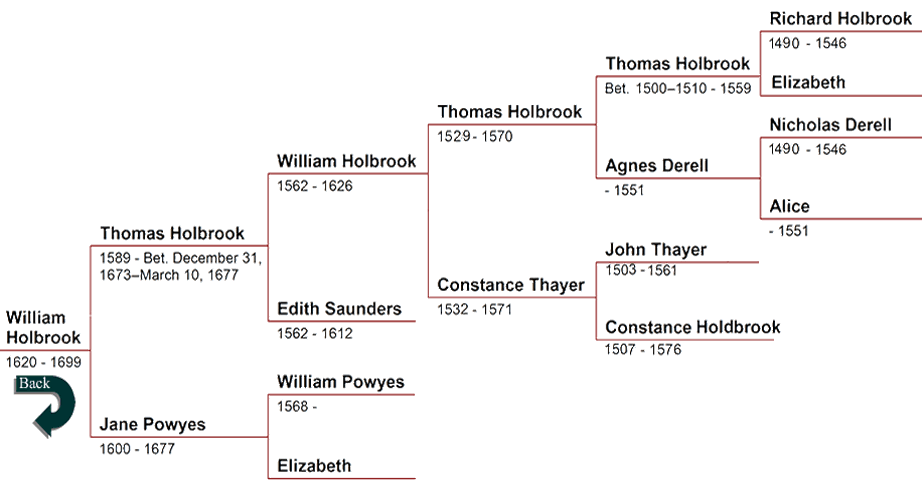
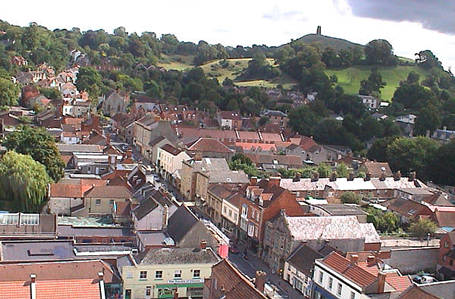 Thomas Holbrook was born about 1589 and baptized March 1, 1599 in
Thomas Holbrook was born about 1589 and baptized March 1, 1599 in  Thomas Holbrook died between December 31, 1673, the date of a codicil to his will, and March 10, 1677, the date of inventory. His will, proved on Apr. 24, 1677, Weymouth, Massachusetts, names wife Jane, three sons, three married daughters, and grandchildren John, Peter and William Holbrook. He gave his sword to one grandchild, his gun to another, and his musket to a third. His sons were requested, in regard to their mother, "to be helpful to her in all ways as she is ancient and weak of body." To his son, John, he gave a double share of the estate.
Thomas Holbrook died between December 31, 1673, the date of a codicil to his will, and March 10, 1677, the date of inventory. His will, proved on Apr. 24, 1677, Weymouth, Massachusetts, names wife Jane, three sons, three married daughters, and grandchildren John, Peter and William Holbrook. He gave his sword to one grandchild, his gun to another, and his musket to a third. His sons were requested, in regard to their mother, "to be helpful to her in all ways as she is ancient and weak of body." To his son, John, he gave a double share of the estate. 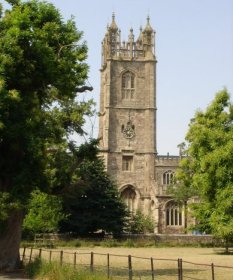
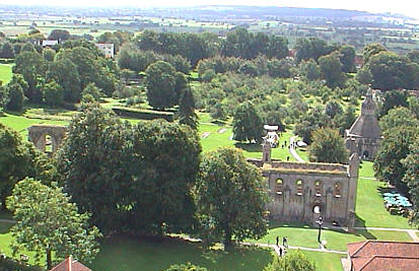 The town of Glastonbury, at the heart of the county of Somerset, is one of the best-known places in England. Its historical and archaeological importance is out of all proportion to its relatively small size. Its fame rests chiefly upon myths generated ages ago which link the place to Joseph of Arimathea and King Arthur. But it is also celebrated for the ruins of its ancient abbey church, the Iron Age lake villages of Glastonbury and Meare and the Glastonbury Festival.
The town of Glastonbury, at the heart of the county of Somerset, is one of the best-known places in England. Its historical and archaeological importance is out of all proportion to its relatively small size. Its fame rests chiefly upon myths generated ages ago which link the place to Joseph of Arimathea and King Arthur. But it is also celebrated for the ruins of its ancient abbey church, the Iron Age lake villages of Glastonbury and Meare and the Glastonbury Festival.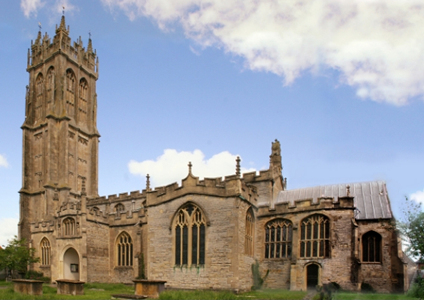 The St. John the Baptist Church is in the middle of the town and was probably founded in the Saxon 950's when Dunstan was reforming the life of the monks in Glastonbury Abbey. The Norman abbots later appropriated the church’s income and with it responsibility for the parish; this lasted until 1539. However, much of the medieval work to the church and its fittings was financed by the parishioners. Some of the Churchwardens records date back to the 1300s giving details of the maintenance and rebuilding of the church in medieval times. The central Norman tower partially collapsed in the early 1400s and the present west tower replaced it by about 1475. Dunstan is said to have introduced bellfounding in Glastonbury 1,000 years ago. Although all of the pre-reformation bells were recast at least once they may still be ringing some of the bell metal that was in the tower over 500 years ago. The earliest bell reference is for the replacement of three ropes in 1403.
The St. John the Baptist Church is in the middle of the town and was probably founded in the Saxon 950's when Dunstan was reforming the life of the monks in Glastonbury Abbey. The Norman abbots later appropriated the church’s income and with it responsibility for the parish; this lasted until 1539. However, much of the medieval work to the church and its fittings was financed by the parishioners. Some of the Churchwardens records date back to the 1300s giving details of the maintenance and rebuilding of the church in medieval times. The central Norman tower partially collapsed in the early 1400s and the present west tower replaced it by about 1475. Dunstan is said to have introduced bellfounding in Glastonbury 1,000 years ago. Although all of the pre-reformation bells were recast at least once they may still be ringing some of the bell metal that was in the tower over 500 years ago. The earliest bell reference is for the replacement of three ropes in 1403. 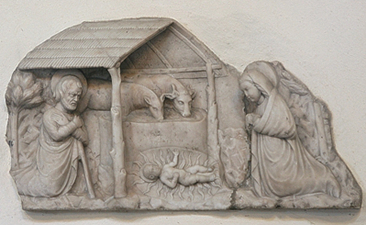 "A fair lightsome church" so Leland the historian described it in 1534, and so it strikes the visitor on entering it today. Two tall arcades of seven bays with clerestory windows above. The slender piers are of standard Somerset design with four hollows. The aisle windows are early 15th Century, while the clerestory windows are of later design. Between these windows are shafts arising from angel corbels, which support the late 15th Century roof. This roof is more ornate than appears at first sight, being adorned with bosses, moldings and tracery work. This must have been the roof which was extensively repaired after the fall of the pinnacles. Sixteen oak trees from Witham Friary were used for this. The tower arch is paneled and of fine proportions whilst above is fan vaulting. In the south aisle is the war memorial and a small 15th Century Italian marble relief of the Nativity, bought in Sicily (pictured right). Below the pulpit is the tomb of John Cammell, who died in 1487. The purse suggests that he was a lay treasurer of the Abbey but records indicate that he carried out legal work for the Abbot. The fine alabaster carving has many traces of its original covering. Camels are carved on the tomb below.
"A fair lightsome church" so Leland the historian described it in 1534, and so it strikes the visitor on entering it today. Two tall arcades of seven bays with clerestory windows above. The slender piers are of standard Somerset design with four hollows. The aisle windows are early 15th Century, while the clerestory windows are of later design. Between these windows are shafts arising from angel corbels, which support the late 15th Century roof. This roof is more ornate than appears at first sight, being adorned with bosses, moldings and tracery work. This must have been the roof which was extensively repaired after the fall of the pinnacles. Sixteen oak trees from Witham Friary were used for this. The tower arch is paneled and of fine proportions whilst above is fan vaulting. In the south aisle is the war memorial and a small 15th Century Italian marble relief of the Nativity, bought in Sicily (pictured right). Below the pulpit is the tomb of John Cammell, who died in 1487. The purse suggests that he was a lay treasurer of the Abbey but records indicate that he carried out legal work for the Abbot. The fine alabaster carving has many traces of its original covering. Camels are carved on the tomb below.